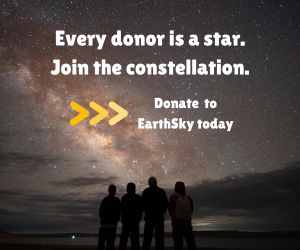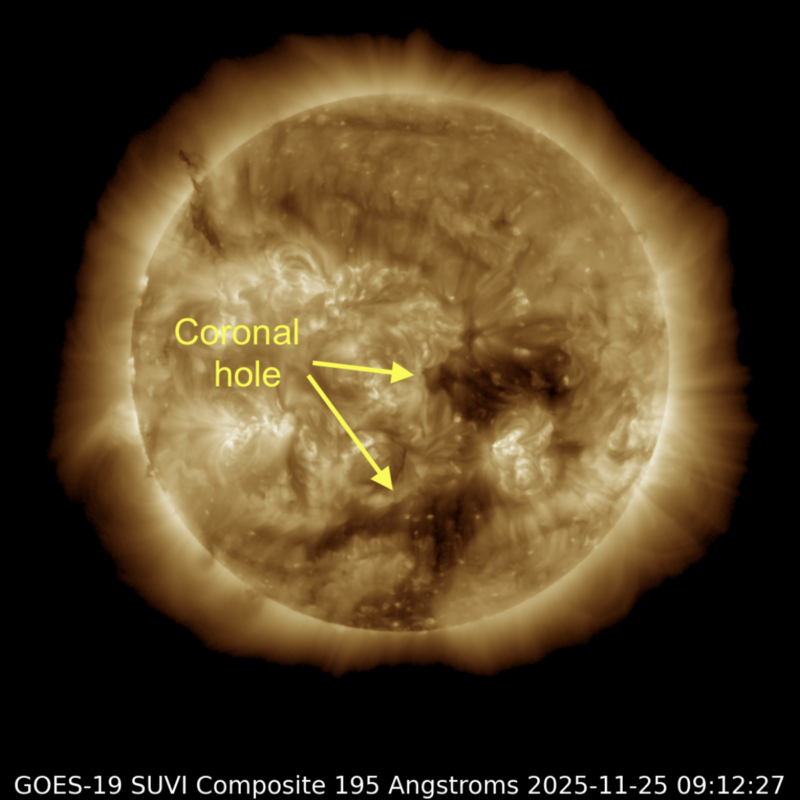
Sun news November 25: Solar coronal holes spark geomagnetic storms!
Today’s top story: Surprise! We got a G1 (minor) geomagnetic storm last night, with auroras at high latitudes, beginning around 0 UTC on November 25. The stormy conditions stemmed from an early-arriving co-rotating interaction region (CIR), which is fast solar wind streams interacting with slower solar wind ahead of it. Long story short … the solar wind disturbed Earth’s magnetic field and pushed the Kp index (a measure of the disturbance) to level 5 during two three-hour synoptic periods. As of this writing, Kp = 5 remains ongoing. And here’s more exciting news! The coronal holes are still in a geoeffective position, where they are capable of affecting Earth. So active conditions with isolated G1 geomagnetic storming might continue through November 27. Did you see the auroras last night? Took photos? Share them with our community!
Past 24 hours: The details
(11 UTC November 24 – 11 UTC November 25)
- Flare activity: Sun activity remained at a very low level, with mostly B-class (weak) flares during the 24-hour period. A total of nine flares were observed: two C-class (common) and seven B-class flares.
- Strongest flare: A faint C1.6 flare from AR4291 at 22:03 UTC on November 24. These common, low-level eruptions do not produce radio blackouts.
- Other notable flares: A C1.3 from AR4291 at 22:20 UTC on November 24. All remaining flares were B-class.
- Sunspot regions: Six numbered active regions appeared on the Earth-facing side of the sun.
- AR4291 (beta-gamma) remained the most complex region on the disk, producing both C- and B-class flares. It retains the potential for larger flares.
- AR4290 (beta) showed decay and produced no flares.
- AR4289 (alpha) produced one faint B-class flare and otherwise remained simple and stable.
- AR4293, a newcomer in the northeast quadrant, remained quiet.
- The remaining numbered regions stayed mostly stable or in gradual decay, contributing minimal flare activity.
- Blasts from the sun? No Earth-directed coronal mass ejections (CMEs) appeared in available satellite imagery during the period. Coronagraph data from SOHO and other spacecraft showed no significant eruptions heading toward Earth.
- Solar wind: Solar wind speeds fluctuated dramatically. Speeds hovered near 700 km/s during the first half of the period (on November 24), dropped to 260 km/s by 5 UTC today, then surged to 765 km/s by 10 UTC on November 25. The interplanetary magnetic field (IMF) remained moderate, averaging around 8 nT. The Bz component repeatedly switched from northward to southward, with the strongest southward peaks reaching -10 nT. Bz remained southward at 10 UTC on November 25, a configuration that favors auroral activity.
- Earth’s magnetic field: Earth’s magnetic field ranged from unsettled to active levels. G1 (minor) geomagnetic storm conditions occurred, with the Kp index reaching 5 from 0–3 UTC and again from 6–9 UTC on November 25. At the time of this writing, Kp remains at 5.
What’s ahead? Sun–Earth forecast
- Flare activity forecast: Low activity is expected through November 26. Chances for moderate M-class flares remain near 15%, driven mainly by AR4291. This region’s beta-gamma magnetic configuration gives it the potential to produce isolated M-class flares as it rotates further into a geoeffective position. The probability of stronger X-class flares remains low (1%) but cannot be fully ruled out.
- Geomagnetic activity forecast:
- November 25: Earth’s geomagnetic field to continue enhanced to unsettled to active conditions with more isolated G1 (minor) geomagnetic storming as fast wind from a coronal hole high-speed stream (CH HSS) now at geoeffective position continues sending its fast solar wind to us combined with a co-rotating interaction region (CIR).
- November 26: Active conditions (Kp 4–5) with G1 storm levels likely as the coronal hole continues to influence Earth. Solar wind speeds are expected to remain elevated at 600–700 km/s through the day. Auroras may be visible from Toronto, Chicago, Boston, northern England and Scotland. Enhanced conditions may persist through the end of the forecast period.

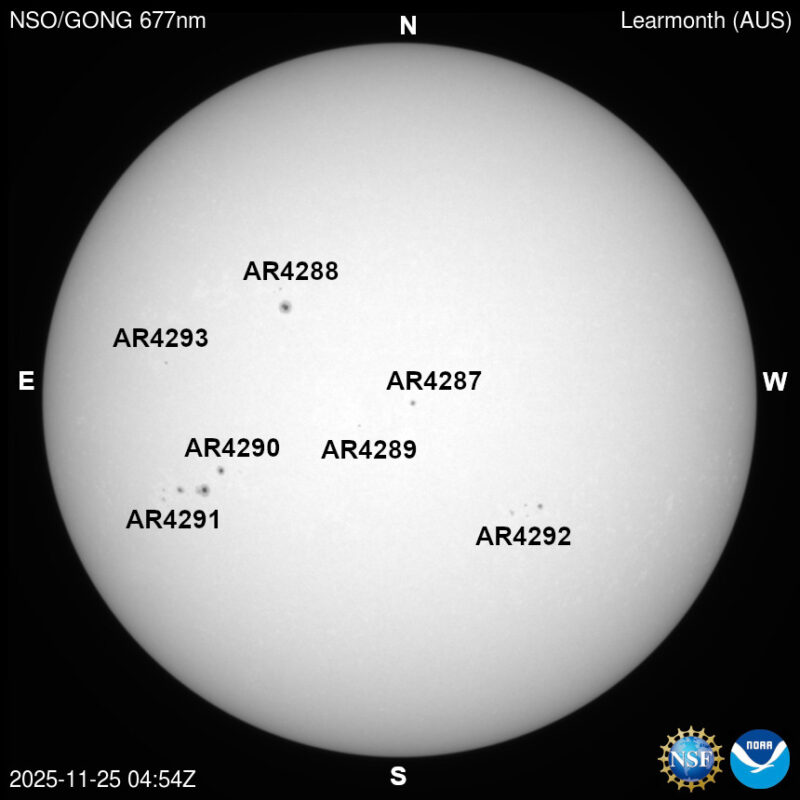
Sun news November 24: Solar activity breather continues
Our star appears to be taking a breather, firing only C (common) and B (weak) flares over the past day. The strongest of these was a C2.5 flare from sunspot region AR4290, which briefly lit up the solar disk. The most productive region, however, was AR4291 in the southeast, which shows promising complexity and continues to develop more sunspots. This region is the one to watch, especially as it starts to rotate into a more geoeffective position.
Past 24 hours: The details
(11 UTC November 23 – 11 UTC November 24)
- Flare activity: Solar activity remained at low levels, with 8 C-class flares and 3 B flares observed during the 24-hour period.
- Strongest flare: C2.5 from AR4290 at 6:21 UTC on November 24. This common, low-level eruption produced no radio blackouts.
- Other notable flares: C2.5 from AR4291 at 6:03 UTC on November 24; C1.6 from AR4290 at 20:10 UTC on November 23; C1.5 from AR4291 at 12:30 UTC on November 23; C1.3 from AR4290 at 2:32 UTC on November 24.
- Sunspot regions: The Earth-facing solar disk currently displays 6 numbered active regions, with one newly formed region appearing over the past day.
- AR4291 (beta-gamma) remained the most complex region on the disk, developing additional intermediate spots and maintaining its status as the lead flare producer. This southeast region is responsible for the majority of C-class activity and bears watching as it rotates into a more geoeffective position.
- AR4292 (beta) was newly numbered during the period. This fresh region remained mostly inactive but adds to the overall sunspot count.
- AR4290 produced multiple C-class flares including the period’s strongest C2.5 event. This region shows modest activity despite its simpler magnetic configuration.
- AR4288 contributed a single C1.0 flare but otherwise remained relatively quiet.
- The remaining numbered active regions were either mostly stable or in gradual decay, showing minimal flare production during the period.
- Blasts from the sun? No Earth-directed coronal mass ejections (CMEs) were observed in available satellite imagery during the period. Coronagraph data from SOHO and other spacecraft showed no significant plasma eruptions heading toward Earth.
- Solar wind: Solar wind speeds initially hovered near 350 km/s – typical background conditions – before rising to around 500 km/s at 16:44 UTC on November 23. The interplanetary magnetic field (IMF) remained moderate, with total field strength peaking at 13 nT at 18:33 UTC on November 23. The important north–south Bz component reached as far south as –8 nT at 11:57 UTC on November 23. A southward Bz favors aurora displays.
- Earth’s magnetic field: Earth’s magnetic field ranged from quiet to unsettled levels, with Kp indices reaching 4 during an isolated active period from 15–18 UTC on November 23. Geomagnetic activity remained below storm levels throughout the period. The brief active interval corresponded with the moderately southward Bz orientation, which enhanced energy coupling between the solar wind and Earth’s magnetosphere. Conditions returned to quiet-to-unsettled levels following this period.

Sun news for November 23-24, 2025. The sun appears to be taking a break, firing only C (common) and B (weak) flares over the past 24 hours. Here, the sun is captured in the 304 and 171 angstrom wavelengths of the Solar Dynamics Observatory (SDO). Images via NASA/ SDO. The sun in recent days
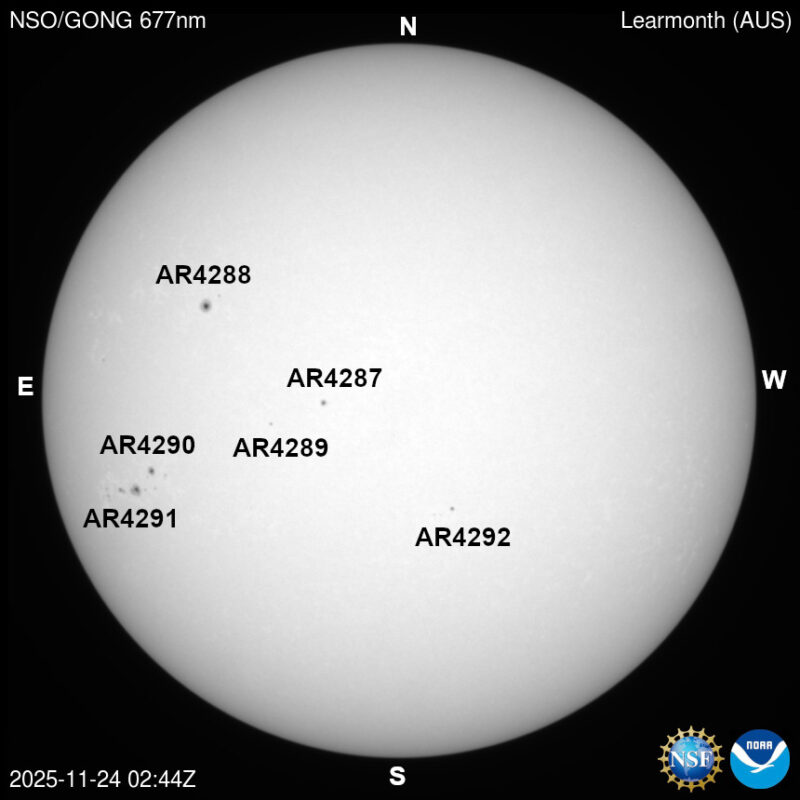
This image shows sun activity – with the most active regions labeled – as of 2 UTC on November 24, 2025, as seen from Learmonth Solar Observatory in Australia. Image via NSO/ GONG. 
This image shows sun activity – with the most active regions labeled – as of 5 UTC on November 23, 2025, as seen from Learmonth Solar Observatory in Australia. Image via NSO/ GONG. 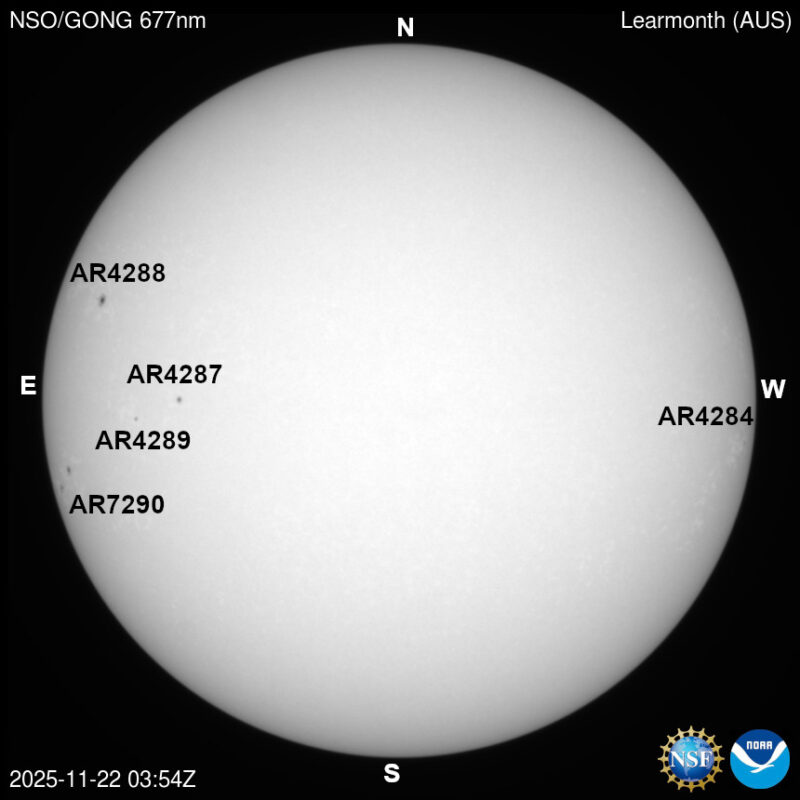
This image shows sun activity – with the most active regions labeled – as of 3 UTC on November 22, 2025, as seen from Learmonth Solar Observatory in Australia. Image via NSO/ GONG. Sun images from our community

View at EarthSky Community Photos. | Patricio León in Santiago, Chile, captured this filtered image of the sun on November 24, 2025. Patricio wrote: “Scattered sunspots. No significant activity. Fast solar wind.” Thank you, Patricio! 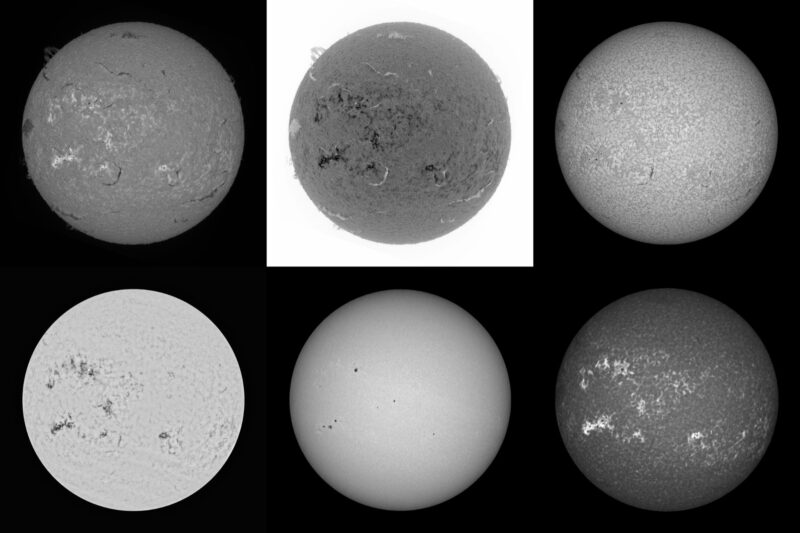
View at EarthSky Community Photos. | Mario Rana in Hampton, Virginia, captured these filtered images on November 24, 2025. Mario wrote: “The sun in hydrogen-alpha, hydrogen-beta, helium D3, iron 588.4 nm, and calcium-H. Beautiful prominence on the northeast limb!” Thank you, Mario! 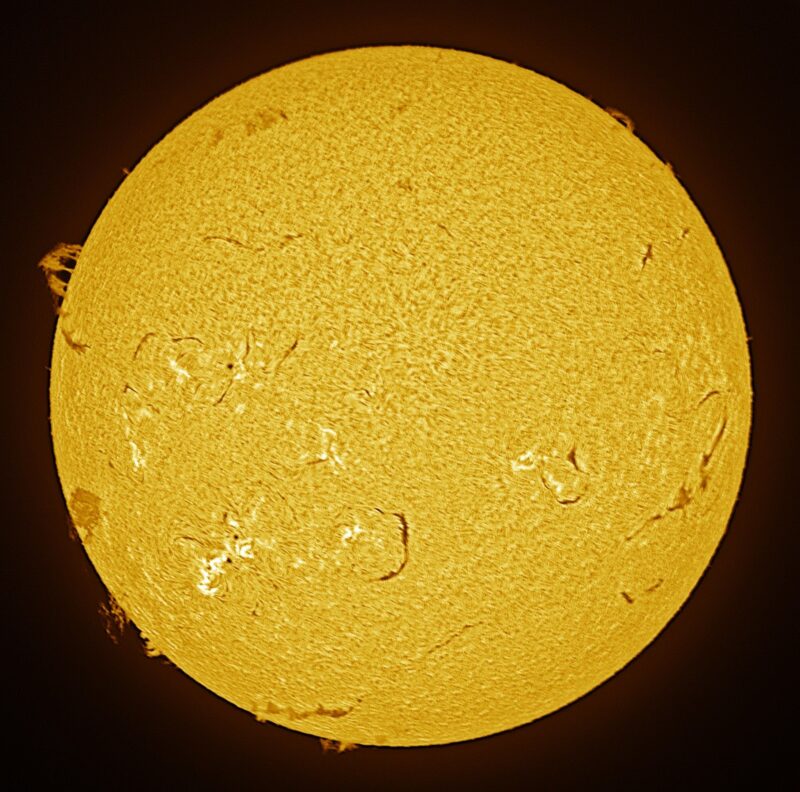
View at EarthSky Community Photos. | Jim Militello in Tucson, Arizona, captured this filtered image of the sun on November 24, 2025. Jim wrote: “Hydrogen-alpha image of the sun showing active regions, prominences and filaments.” Thank you, Jim! 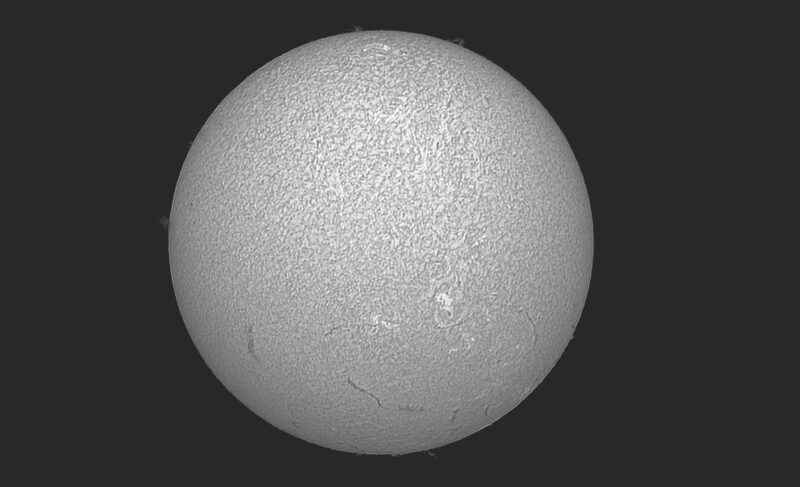
View at EarthSky Community Photos. | Valerie Liard in Epernay, Marne, France, captured this filtered image on November 18, 2025. Valerie wrote: “Hello EarthSky, here is my first hydrogen-alpha photo of the sun taken yesterday morning. I am just starting with processing. The seeing wasn’t great–will see later for better focus–but I’m happy for only my second session.” Thank you, Valerie! We sometimes feature sun images obtained using hydrogen-alpha filters. Read why.
Bottom line: Sun news November 25, 2025: A burst of solar activity lit up high-latitude skies with auroras last night, and more colorful displays may flicker through November 27.





